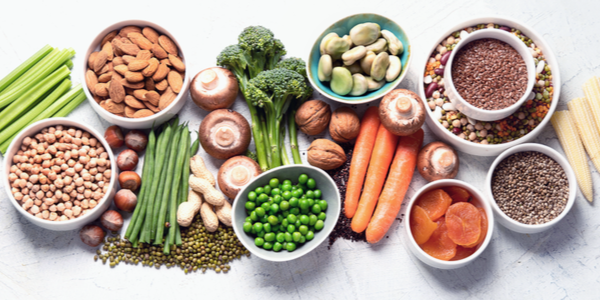
What do whole grains, legumes, nuts, seeds, fruits, and veggies all have in common? While they are all considered healthy parts of a diet, they are also fiber-rich foods which further contribute to their superfood status. Even though most recognize fiber is important in the diet, what fiber is and what it does can be evasive.
What is fiber and is a high fiber diet really that important? Read below to learn what fiber is, what fiber does, and the benefits it adds to health.
What Is Fiber?
Dietary fiber is a plant component that cannot be absorbed or digested by the body. Hence, fiber is only derived from plant foods, not animal foods (meat, seafood, dairy, eggs).
Instead of getting absorbed and used for energy, fiber passes down the gastrointestinal tract and remains relatively intact. Certain fibers can be considered prebiotics, which act as fuel to help grow beneficial bacteria in the gut.
Some types of fiber called soluble fiber can get out of the gastrointestinal tract and into the bloodstream. Once there, this gel-like fiber offers heart health and blood sugar benefits.
Soluble vs Insoluble Fiber
While most nutrition labels do not differentiate between fiber types, there are actually two main categories of fiber, including soluble and insoluble fibers. Both types of fiber are important and offer different health benefits.
• Soluble fiber: This type of fiber can be thought of as a sponge. When soluble fiber is ingested, it absorbs with water and forms a gel-like substance. Soluble fiber foods include oats, fruits, and beans.
• Insoluble fiber: Unlike soluble fiber that absorbs with water, insoluble fiber does not dissolve. Instead, it can be thought of as roughage and bulk-forming. Nuts, vegetables, and potatoes are good sources of insoluble fiber.
Overall, soluble fiber dissolves while insoluble fiber adds bulk. Most plants are sources of soluble fiber and insoluble fiber, though tend to vary in amounts.
What Does Fiber Do?
Why is getting enough fiber so important for health? Research has shown high fiber intakes are associated with:
• Lower serum/blood cholesterol concentrations
• Lower risk of coronary heart disease
• Reduced blood pressure
• Enhanced weight control
• Better glycemic control
• Reduced risk of certain forms of cancer
• Improved gastrointestinal function.
Here is a closer look at what benefits fiber offers to digestive health, weight management, and more.
Digestive Health
Fiber promotes digestive health and regularity, especially thanks to "bulk-forming" insoluble fiber sources like vegetables, whole grains, and nuts/seeds. Additionally, fiber may reduce the risk of developing gastrointestinal diseases of the colon, hemorrhoids, and colorectal cancer.
Heart Health
Soluble fiber can decrease the opportunity for heart disease related to its "sponge-like" characteristic. Thinking back to the sponge analogy, soluble fiber can help "soak" up cholesterol and excrete it from the body.
With high cholesterol contributing to heart disease, eating soluble fiber can help reduce cholesterol levels. Managing cholesterol helps lower the risk for heart disease.
Weight Management
Foods high in fiber are relatively low in calories and more filling compared to foods lesser in fiber. Since likely more apt to eat less and stay sustained longer while following a high-fiber diet, weight loss and maintenance may follow.
Blood Sugar Control
Soluble fiber can offer the benefit of better glycemic control. A 2006 study concluded low-fat and high-fiber intakes decreased diabetes risk independently of body weight change and physical activity.
Overall, this suggests fiber has an important and significant effect for positively affecting blood sugar regulation.
Fiber Recommendations
Despite all the benefits fiber offers, most people do not get enough fiber in the diet. It is estimated only 5 percent of Americans meet daily fiber recommendations.
How much fiber should you get per day? The Institute of Medicine recommends the below daily fiber recommendations based on age and sex.
How can these daily amounts of fiber be met? Actually, unless recommended to a low-fiber diet, one can increase fiber with ease!
Eating a variety of fiber-rich foods - fruits, vegetables, whole grains, nuts/seeds, and legumes - can provide these levels of grams of fiber per day (and more).
In Conclusion on Fiber
Fiber is known to be an important dietary component that is found in plant-based foods. Eating adequate fiber from both soluble and insoluble fiber offers many health benefits ranging from bowel health, heart health, weight management, and blood sugar regulation.
Most Americans do not get enough fiber in their diet. Eating a diet rich in a variety of foods like fruits, vegetables, whole grains, legumes, and nuts/seeds can help provide both types of fiber and meet or even exceed fiber recommendations.
Reference:
Quagliani D, Felt-Gunderson P. Closing America's Fiber Intake Gap: Communication Strategies From a Food and Fiber Summit. American journal of lifestyle medicine. Published July 7, 2016. https://www.ncbi.nlm.nih.gov/pmc/articles/PMC6124841/.







